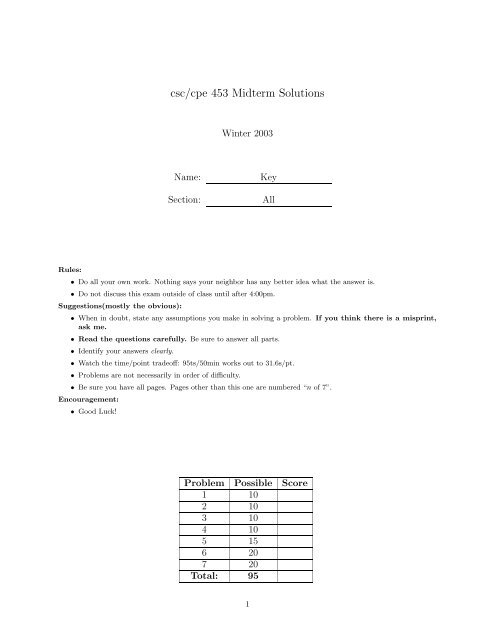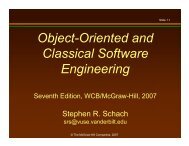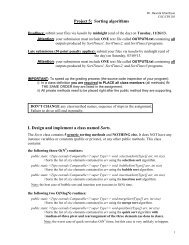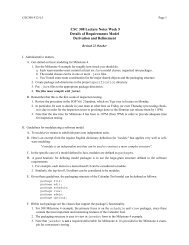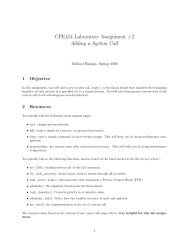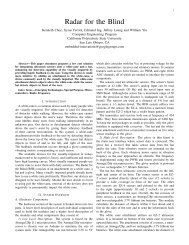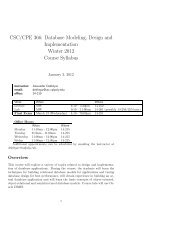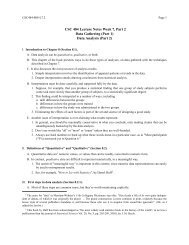csc/cpe 453 Midterm Solutions
csc/cpe 453 Midterm Solutions
csc/cpe 453 Midterm Solutions
Create successful ePaper yourself
Turn your PDF publications into a flip-book with our unique Google optimized e-Paper software.
Rules:<br />
<strong>csc</strong>/<strong>cpe</strong> <strong>453</strong> <strong>Midterm</strong> <strong>Solutions</strong><br />
Winter 2003<br />
Name: Key<br />
Section: All<br />
• Do all your own work. Nothing says your neighbor has any better idea what the answer is.<br />
• Do not discuss this exam outside of class until after 4:00pm.<br />
Suggestions(mostly the obvious):<br />
• When in doubt, state any assumptions you make in solving a problem. If you think there is a misprint,<br />
ask me.<br />
• Read the questions carefully. Be sure to answer all parts.<br />
• Identify your answers clearly.<br />
• Watch the time/point tradeoff: 95ts/50min works out to 31.6s/pt.<br />
• Problems are not necessarily in order of difficulty.<br />
• Be sure you have all pages. Pages other than this one are numbered “n of 7”.<br />
Encouragement:<br />
• Good Luck!<br />
Problem Possible Score<br />
1 10<br />
2 10<br />
3 10<br />
4 10<br />
5 15<br />
6 20<br />
7 20<br />
Total: 95<br />
1
<strong>csc</strong>/<strong>cpe</strong> <strong>453</strong> <strong>Midterm</strong> <strong>Solutions</strong> Winter 2003<br />
Answer the following questions clearly, concisely, and (where possible) correctly.<br />
1. (10) Busywaiting is often denegrated in the concurrent programming community as a<br />
crude and inefficient practice. However, it has its place.<br />
(a) First, what is busywaiting?<br />
Solution:<br />
Busywaiting is the process of repeatedly checking a condition (in a tight<br />
loop, e.g.) until it becomes true.<br />
(b) Under what circumstances would it be appropriate to choose a busywaiting approach?<br />
Solution:<br />
It would be appropriate to choose a busywaiting solution:<br />
(a) when the expected wait time is small,<br />
(b) when there is nothing else to do until the condition is satisfied, or<br />
(c) when there is no other mechanism available through which to synchronize.<br />
The first and third of these points are often true of synchronizing between processors<br />
of a multiprocessor.<br />
2. (10) Semaphore waiting lists are often implemented as queues served in FIFO order.<br />
Could they be implemented as stacks? What problems might this cause?<br />
Solution:<br />
Certainly one could implement semaphore waiting lists as stacks, but doing<br />
so would make concurrent processes synchronizing via semaphores much more<br />
vulnerable to starvation.<br />
2 of 7
<strong>csc</strong>/<strong>cpe</strong> <strong>453</strong> <strong>Midterm</strong> <strong>Solutions</strong> Winter 2003<br />
3. (10) What will be the output of the following program? Explain.<br />
Solution:<br />
% a.out<br />
Hello.<br />
Goodbye!<br />
Goodbye!<br />
Goodbye!<br />
Goodbye!<br />
Goodbye!<br />
Goodbye!<br />
Goodbye!<br />
Goodbye!<br />
%<br />
int main(int argc, char *argv[]){<br />
printf("Hello.\n");<br />
fork();<br />
fork();<br />
fork();<br />
printf("Goodbye!\n");<br />
return 0;<br />
}<br />
parent<br />
"Goodbye!"<br />
parent<br />
"Hello."<br />
parent c1<br />
parent c2 c1 c3<br />
c4<br />
"Goodbye!"<br />
c2<br />
"Goodbye!"<br />
c6<br />
"Goodbye!"<br />
c1<br />
"Goodbye!"<br />
c5<br />
"Goodbye!"<br />
c3<br />
"Goodbye!"<br />
c7<br />
"Goodbye!"<br />
This program prints “Hello” once in the parent, and “Goodbye!” in each of<br />
the 8 resulting processes. There are 7 children created, not 3, because each of<br />
the children executes the following fork()s, too.<br />
4. (10) A programmer dissatisfied with the behavior of a C library function can redefine it<br />
without limiting the capabilities of the program. (That is, there is nothing the program<br />
could have done before the redefinition that it could not do afterwards.) A system call,<br />
however cannot be replaced without limiting the program. Why is this?<br />
Solution:<br />
It all has to do with privilege:<br />
A system call is the means by which the kernel provides access to a particular<br />
operating system service, and the services available through system calls (e.g.,<br />
reading and writing the disk, allocating memory, starting new processes, etc.)<br />
are reserved to the kernel; there is no other way of doing these things. Replacing<br />
a system call eliminates that particular entry to the kernel, limiting the program.<br />
A library call, in contrast, is code that runs entirely within the user’s program<br />
requiring only the user’s privileges. This code can be replaced by a do-ityourselfer<br />
(masochist?) without giving up anything irreplaceable.<br />
3 of 7
<strong>csc</strong>/<strong>cpe</strong> <strong>453</strong> <strong>Midterm</strong> <strong>Solutions</strong> Winter 2003<br />
5. (15) Given the following program:<br />
Solution:<br />
int main(int argc, char *argv[]){<br />
int n;<br />
for(n = 1; n < argc; n++ )<br />
execvp( argv[n], &(argv[n]) );<br />
return 0;<br />
}<br />
Suppose that it is compiled in the current directory as myprog and that one gives the<br />
command:<br />
% myprog myprog ls myprog myprog myprog<br />
(a) How many times will execvp() be called during the run of this program?<br />
execvp() will be called twice.<br />
(b) What will be the expected output of the run?<br />
(c) Explain.<br />
myprog myprog myprog<br />
The program is called with argv containing the list above. Each time<br />
around the loop (1...n-1) it will exec() argv[n] with arguments argv[n+1]<br />
. . . argv[argc-1]. Because the exec() replaces the current program, the<br />
loop never actually loops in any of them.<br />
So, the original instance of myprog calls execvp() with “myprog ls<br />
myprog myprog myprog” as its arguments. This new instance of myprog<br />
will call execvp() with “ls myprog myprog myprog” as its arguments. ls<br />
will proceed to list each of its arguments. Since we know myprog is in the<br />
current directory, it will be found, so the result of the listing will be “myprog<br />
myprog myprog”.<br />
4 of 7
<strong>csc</strong>/<strong>cpe</strong> <strong>453</strong> <strong>Midterm</strong> <strong>Solutions</strong> Winter 2003<br />
6. (20) Assume you have hacked the kernel and are using a version of minix with a 1<br />
second(!) quantum. Suppose there are five user-level jobs, labeled A through E, that<br />
require the following amounts of time to run (if they could get the whole CPU to<br />
themselves).<br />
Job Time<br />
A 2 sec.<br />
B 3 sec.<br />
C 4 sec.<br />
D 5 sec.<br />
E 2 sec.<br />
Supposing that these five jobs become runnable at very close to the same time and are<br />
initially added to the run queue in alphabetical order, answer the following questions.<br />
Recall that within a priority class, minix uses round-robin scheduling. You may assume<br />
that these are the only five jobs in the system and that the overhead required for context<br />
switches is negligible.<br />
(a) After how many seconds will each job terminate? Briefly explain your reasoning.<br />
Job Finish Time<br />
A 6 sec.<br />
B 11 sec.<br />
C 14 sec.<br />
D 16 sec.<br />
E 10 sec.<br />
Solution<br />
Time<br />
Ending A B C D E<br />
0.0s — — — — —<br />
1.0s 1.0s — — — —<br />
2.0s — 1.0s — — —<br />
3.0s — — 1.0s — —<br />
4.0s — — — 1.0s —<br />
5.0s — — — — 1.0s<br />
6.0s 2.0s — — — —<br />
7.0s 2.0s — — —<br />
8.0s — 2.0s — —<br />
9.0s — — 2.0s —<br />
10.0s — — — 2.0s<br />
11.0s 3.0s — —<br />
12.0s 3.0s —<br />
13.0s — 3.0s<br />
14.0s 4.0s —<br />
15.0s 4.0s<br />
16.0s 5.0s<br />
5<br />
4<br />
3<br />
2<br />
0<br />
1<br />
A<br />
B<br />
C<br />
D<br />
E<br />
A<br />
B<br />
C<br />
0 16 32 48 64 80 96 112 128 144 160<br />
Time (x100.0ms)<br />
(b) Now suppose that job D issues an I/O request after each 1.4s it is allowed to run.<br />
This I/O request takes 200ms (0.2s) to complete and causes D to block. Now how<br />
long will it take for each job to complete? Again, explain your reasoning.<br />
Job Finish Time<br />
A 6.0 sec.<br />
B 10.4 sec.<br />
C 13.4 sec.<br />
D 16.4 sec.<br />
E 9.4 sec.<br />
Solution:<br />
D’s first IO is masked by<br />
E’s execution, but for the<br />
second two, there is nothing<br />
else to do.<br />
Solution<br />
Time<br />
End A B C D E<br />
0.0s — — — — —<br />
1.0s 1.0s — — — —<br />
2.0s — 1.0s — — —<br />
3.0s — — 1.0s — —<br />
4.0s — — — 1.0s —<br />
5.0s — — — — 1.0s<br />
6.0s 2.0s — — — —<br />
7.0s 2.0s — — —<br />
8.0s — 2.0s — —<br />
8.4s — — 1.4s —<br />
9.4s — — — 2.0s<br />
10.4s 3.0s — —<br />
11.4s 3.0s —<br />
12.4s — 2.4s<br />
13.4s 4.0s —<br />
13.8s 2.8s<br />
14.0s —<br />
15.0s 3.8s<br />
15.4s 4.2s<br />
15.6s —<br />
16.4s 5.0s<br />
5 of 7<br />
5<br />
4<br />
3<br />
2<br />
1<br />
0<br />
A<br />
B<br />
C<br />
D<br />
E<br />
A<br />
D<br />
B<br />
E<br />
C<br />
B<br />
D<br />
0 16 32 49 65 82 98 114 131 147 163<br />
Time (x100.0ms)<br />
C<br />
IO<br />
E<br />
D<br />
C<br />
B<br />
D D<br />
C<br />
D<br />
C<br />
D D<br />
IO<br />
D D<br />
IO
<strong>csc</strong>/<strong>cpe</strong> <strong>453</strong> <strong>Midterm</strong> <strong>Solutions</strong> Winter 2003<br />
7. (20) Consider the following situation: A very narrow hurricane has washed out all but<br />
one lane of the Lake Pontchartrain Causeway 1 . Given that it is a very large lake, going<br />
around is impractical, so it is necessary to come up with a system to keep the bridge<br />
open. The conditions:<br />
• Cars arrive at random intervals from either the north or south.<br />
• The remains of the bridge are only one car wide and cars cannot back up. That is, a car that meets<br />
another car is stuck forever.<br />
• Whenever a car wants to enter the bridge, it calls the function enter bridge(int direction) with a<br />
pre-defined integer constant indicating the direction. This will be either NORTH or SOUTH. When it wants<br />
to leave, it calls exit bridge(int dir).<br />
Using semaphores and the C-like syntax used for semaphore examples in class and in<br />
Tanenbaum and Woodhull, develop a solution to the problem. Implement enter bridge()<br />
and exit bridge() and whatever auxilliary data and functions you may need. Be sure<br />
to explain briefly why your solution works.<br />
For partial credit: produce a solution that allows cars to cross the bridge without risking meeting another<br />
car on the way (and getting stuck forever).<br />
For more partial credit: produce a solution that guarantees that no car will have to wait forever to cross.<br />
For full credit: produce a solution that does all of the above and allows multiple cars travelling in the same<br />
direction to be on the bridge at a time. (It is 24 miles long, after all.)<br />
Write your code below (and on page 7 if necessary):<br />
Solution:<br />
The first two partial credit levels above can be handled by a very simple<br />
solution that uses a single semaphore for exclusive access to the bridge. Exclusive<br />
access guarantees that there will be no accidents or deadlocks, and the<br />
semaphore’s own queueing mechanisms guarantee that nobody will have to wait<br />
forever. See below. A better solution is presented on page 7.<br />
semaphore mutex; /* initialized to 1 */<br />
void enter bridge(direction d) {<br />
/* make sure nobody else is on the bridge */<br />
DOWN(mutex);<br />
}<br />
void exit bridge(direction d) {<br />
/* indicate that the bridge is free */<br />
UP(mutex);<br />
}<br />
A semaphore-based solution to problem 7 that allows one car at a time.<br />
1 Lake Pontchartrain is a lake 41 miles long and 24 miles wide north of New Orleans, La. The causeway is the bridge that<br />
spans the “short” direction and is one of the two roads out of the city.<br />
6 of 7
<strong>csc</strong>/<strong>cpe</strong> <strong>453</strong> <strong>Midterm</strong> <strong>Solutions</strong> Winter 2003<br />
The full solution is much trickier:<br />
To meet all three requirements, we<br />
must not allow traffic in one direction<br />
to hold up traffic in the other<br />
direction forever, but we can’t just<br />
take turns, because a car may never<br />
arrive on the other side, and we still<br />
have to allow multiple cars to cross<br />
in the same direction.<br />
The technique is to check to see if<br />
there are cars on the other side before<br />
entering the bridge. If there are,<br />
we act as if they were already on the<br />
bridge and wait. The last car crossing<br />
in the current direction wakes<br />
up all the waiting cars on the other<br />
side.<br />
The only subtle part if the solution<br />
is the question of what happens<br />
if enter bridge() is interrupted at<br />
line 41 (marked at right). Could it<br />
cause problems if a process were to<br />
decide to wait until cars have cleared<br />
the bridge, but be interrupted before<br />
it an down waitsem?<br />
Consider: The only way a car(C)<br />
could decide to wait is if there is<br />
at least one car on the bridge, and<br />
before the C releases mutex, it has<br />
already been added to the count of<br />
waiting cars. So, the worst that<br />
could happen during an interruption<br />
is that the only car on the bridge<br />
could leave. On its way out, however,<br />
it would put all waiting cars<br />
onto the bridge and up waitsem the<br />
appropriate number of times. So, all<br />
that will happen is that when C does<br />
get to run and downs waitsem, the<br />
operation will succeed without blocking.<br />
Extra space for problem 7<br />
typedef int direction;<br />
#define NORTH 0<br />
#define SOUTH 1<br />
semaphore mutex; /* initialized to 1 */<br />
semaphore waitsem[2]; /* initialized to 0,0 */<br />
direction bridgedir = NORTH; /* direction cars are currently moving */<br />
/* how it is initialized doesn’t matter */<br />
int onbridge = 0; /* there are no cars initially on the bridge */ 10<br />
int waiting[2] = {0,0}; /* nobody is waiting in either direction */<br />
direction otherdir(direction d) {<br />
direction ret;<br />
if ( d == NORTH )<br />
ret = SOUTH;<br />
else<br />
ret = NORTH;<br />
return ret; 20<br />
}<br />
void enter bridge(direction d) {<br />
direction other = otherdir(d);<br />
int willwait = 0;<br />
DOWN(mutex);<br />
if ( onbridge == 0 ) { /* there’s nobody on the bridge, take it */<br />
onbridge = 1;<br />
bridgedir = d; 30<br />
waiting[d] = 0;<br />
} else if ( (onbridge > 0) && /* if somebody’s on the bridge, */<br />
(bridgedir == d) && /* it’s going our way, and nobody’s */<br />
(waiting[other] == 0) ) { /* waiting on the other side */<br />
onbridge = onbridge + 1; /* add ourselves to the bridge */<br />
} else {<br />
waiting[d] = waiting[d] + 1; /* otherwise, we have to wait. */<br />
willwait = 1;<br />
}<br />
UP(mutex); 40<br />
/* HERE HERE HERE */<br />
if ( willwait ) /* if we have to wait, wait */<br />
DOWN(waitsem[d]);<br />
}<br />
void exit bridge(direction d) {<br />
/* indicate that the bridge is free */<br />
direction other = otherdir(d);<br />
DOWN(mutex); 50<br />
onbridge = onbridge−1; /* decrement the counter */<br />
if ( onbridge == 0 ) { /* if we were the last */<br />
if ( waiting[other] != 0 ) {<br />
/* if someone is waiting to go the other way, put them<br />
* on the bridge, then wake those cars up<br />
*/<br />
onbridge = waiting[other];<br />
bridgedir = other;<br />
waiting[other] = 0;<br />
60<br />
for(i=0;i


